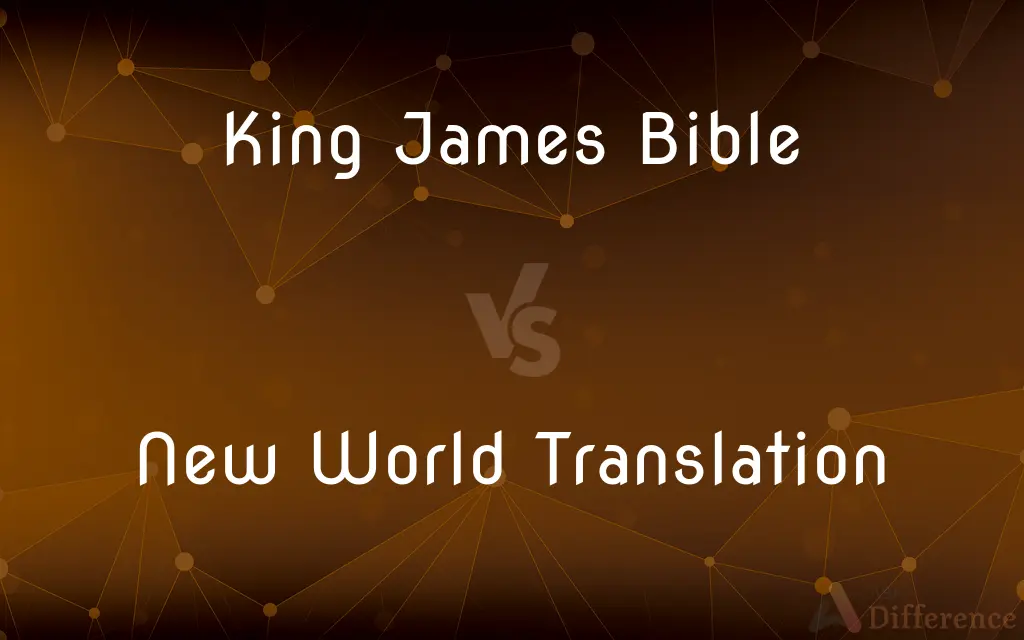King James Bible vs. New World Translation — What's the Difference?
By Maham Liaqat & Urooj Arif — Published on February 20, 2024
King James Bible, completed in 1611, is known for its majestic prose and literary impact. New World Translation, by Jehovah's Witnesses since 1950, focuses on clarity and accuracy from original languages.

Difference Between King James Bible and New World Translation
Table of Contents
ADVERTISEMENT
Key Differences
The KJV was commissioned by King James I of England to unify the Church of England under a common Bible translation. Its translators used existing English translations and original Hebrew, Aramaic, and Greek texts. The KJV's language, while archaic to modern readers, has been celebrated for its literary beauty and has had a profound impact on English-speaking culture and language.
The NWT, produced by the Watch Tower Bible and Tract Society, aims to make the Bible's message clear and accessible in contemporary language. Its translation committee sought to remove traditional biases and provide a version closely aligned with the original texts. Notably, the NWT uses "Jehovah" to represent the divine name, Yahweh, consistently in the Old Testament, a practice not common in most other translations.
Both translations have faced criticism and praise for different reasons. The KJV is critiqued for its older language, which can be difficult for modern readers, and for inaccuracies due to the state of textual scholarship in the early 17th century. The NWT has been criticized by some scholars for translation choices that reflect Jehovah's Witnesses' doctrinal beliefs, though it has also been commended for its efforts to be faithful to the original languages.
The choice between the KJV and the NWT often depends on the reader's preference for traditional versus modern language, as well as doctrinal considerations. The KJV holds a place of historical and cultural significance, while the NWT seeks to offer a version of the Bible that speaks to contemporary readers with an emphasis on what Jehovah's Witnesses believe is an accurate rendering of the original texts.
Comparison Chart
Date Completed
1611
First complete edition in 1961
ADVERTISEMENT
Language Style
Early Modern English
Modern English
Translation Philosophy
Formal equivalence
Combination of formal and dynamic equivalence
Use of Divine Name
Uses "LORD" in place of the Tetragrammaton
Uses "Jehovah" consistently
Textual Basis
Based on the Textus Receptus and the Masoretic Text
Uses modern critical editions of Hebrew and Greek texts
Doctrinal Influence
Anglican, with ecumenical considerations
Jehovah's Witnesses' beliefs
Literary Influence
Significant impact on English literature and language
Designed for clarity and readability, with less focus on literary style
Criticism
Archaic language, textual inaccuracies by modern standards
Accused of doctrinal bias in translation choices
Praise
Literary beauty, doctrinal neutrality
Clarity, use of divine name, accessibility
Compare with Definitions
King James Bible
Formal equivalence.
The KJV often preserves the structure of the original languages.
New World Translation
Dynamic equivalence.
The NWT aims to convey the thoughts of the original texts in modern English.
King James Bible
Ecumenical.
The KJV was intended to be acceptable across different Christian denominations.
New World Translation
Jehovah for divine name.
The NWT uniquely restores 'Jehovah' in both the Old and New Testaments where it believes the divine name appears.
King James Bible
Textus Receptus.
The KJV New Testament was primarily based on the Textus Receptus.
New World Translation
Doctrinal clarity.
The NWT reflects the theological beliefs of Jehovah's Witnesses.
King James Bible
Archaic language.
The KJV's use of phrases like 'thou shalt' reflects its early 17th-century origins.
New World Translation
Critical editions.
The NWT translators utilized the latest critical editions of the Hebrew and Greek texts.
King James Bible
Historical translation.
The KJV has influenced countless works of English literature over the centuries.
New World Translation
Modern language.
The NWT uses contemporary language to make the Bible accessible to today's readers.
Common Curiosities
Can the NWT be used for scholarly work?
While the NWT is praised for its readability and some accurate renderings, its perceived doctrinal biases may limit its use in academic settings not affiliated with Jehovah's Witnesses.
Why does the NWT use "Jehovah" instead of "LORD"?
The NWT uses "Jehovah" to reflect Jehovah's Witnesses' belief in the importance of God's name and its presence in the original scriptures.
Which Bible translation is more historically significant?
The KJV holds greater historical and cultural significance due to its profound impact on English literature and language over several centuries.
Do both translations include the Apocrypha?
The original 1611 KJV included the Apocrypha, but most modern editions do not. The NWT does not include the Apocrypha, reflecting Jehovah's Witnesses' biblical canon.
How do the KJV and NWT handle controversial or difficult passages?
The KJV tends to maintain traditional interpretations and translations reflective of early 17th-century scholarship. The NWT, meanwhile, often adopts interpretations that align with Jehovah's Witnesses' doctrines, which can lead to different renderings of certain passages.
How do both translations approach the New Testament's use of the Old Testament?
The KJV follows traditional Christian interpretations of Old Testament quotations in the New Testament. The NWT may emphasize interpretations that support Jehovah's Witnesses' theological perspectives, particularly regarding prophecies and typologies.
Is the KJV easy to understand for modern readers?
The KJV's early modern English can be challenging for contemporary readers, but many find its literary style rewarding.
How do the translation philosophies of the KJV and NWT differ?
The KJV primarily follows a formal equivalence approach, while the NWT uses a mix of formal and dynamic equivalence to balance accuracy with readability.
Which translation should I choose for personal study?
The choice depends on personal preference, doctrinal beliefs, and the desire for modern language accessibility versus literary style.
Are there any online resources to compare the KJV and NWT side by side?
Yes, several online Bible study tools and websites offer side-by-side comparisons of different Bible translations, including the KJV and NWT, allowing for direct comparison of specific verses or passages.
How do the footnotes and study aids in the KJV and NWT compare?
The KJV in its original form contains minimal footnotes, primarily focused on alternative translations or textual variants. Modern editions may include more extensive study aids. The NWT includes footnotes and appendices that explain translation choices, offer alternative readings, and provide doctrinal commentary from a Jehovah's Witnesses perspective.
What are the guidelines for using the KJV and NWT in worship and study within their respective communities?
Within the Church of England and many Protestant denominations, the KJV is used for public reading, worship, and personal study, revered for its solemnity and beauty. Jehovah's Witnesses use the NWT in their worship services, study meetings, and personal study, valuing it for its clarity and doctrinal consistency.
Can the language of the KJV be a barrier to understanding for contemporary readers?
Yes, the early modern English of the KJV can be challenging for modern readers to understand fully without supplementary aids, potentially hindering comprehension of the biblical text.
What impact has the KJV had on the English language and culture?
The KJV has significantly influenced the English language, contributing phrases and idioms that are still in use today. Its literary and poetic qualities have made it a staple in English literature and education.
How does the NWT address the issue of gender in its translation?
The NWT aims to reflect the original texts accurately, including the use of gender-specific terms. It follows contemporary norms for gender accuracy within the context of Jehovah's Witnesses' doctrinal understandings.
What efforts have been made to update the KJV and NWT?
The KJV has seen various revisions and adaptations (e.g., the New King James Version) that modernize its language while attempting to preserve its stylistic and literary qualities. The NWT has undergone revisions, the most recent being in 2013, to update language, improve accuracy based on recent biblical scholarship, and clarify Jehovah's Witnesses' doctrines.
Which translation is more widely used globally?
The KJV has a broader historical and global reach due to its long history and influence in the English-speaking Christian world. The NWT is widely used among Jehovah's Witnesses worldwide but does not have the same level of adoption outside this community.
How do the KJV and NWT translations influence their respective believers' understanding of Scripture?
The KJV, with its archaic language and formal equivalence approach, may foster a sense of tradition and reverence for Scripture among its readers. The NWT, through its modern language and doctrinal clarity, aims to make the Bible's teachings more accessible and understandable to Jehovah's Witnesses, shaping their theological perspectives and practices.
How do the publishing practices for the KJV and NWT differ?
The KJV is published by a wide range of publishers due to its public domain status, leading to a variety of editions and formats. The NWT is published exclusively by the Watch Tower Bible and Tract Society, ensuring a consistent presentation aligned with Jehovah's Witnesses' standards and doctrinal emphasis.
What has been the reception of the NWT among the wider Christian community?
The NWT has received mixed reviews outside of Jehovah's Witnesses. Some commend its readability and innovative features, while others criticize it for translation choices perceived as doctrinally motivated.
Share Your Discovery

Previous Comparison
10w30 vs. 15w40
Next Comparison
Copper 1 vs. Copper 2Author Spotlight
Written by
Maham LiaqatCo-written by
Urooj ArifUrooj is a skilled content writer at Ask Difference, known for her exceptional ability to simplify complex topics into engaging and informative content. With a passion for research and a flair for clear, concise writing, she consistently delivers articles that resonate with our diverse audience.
















































